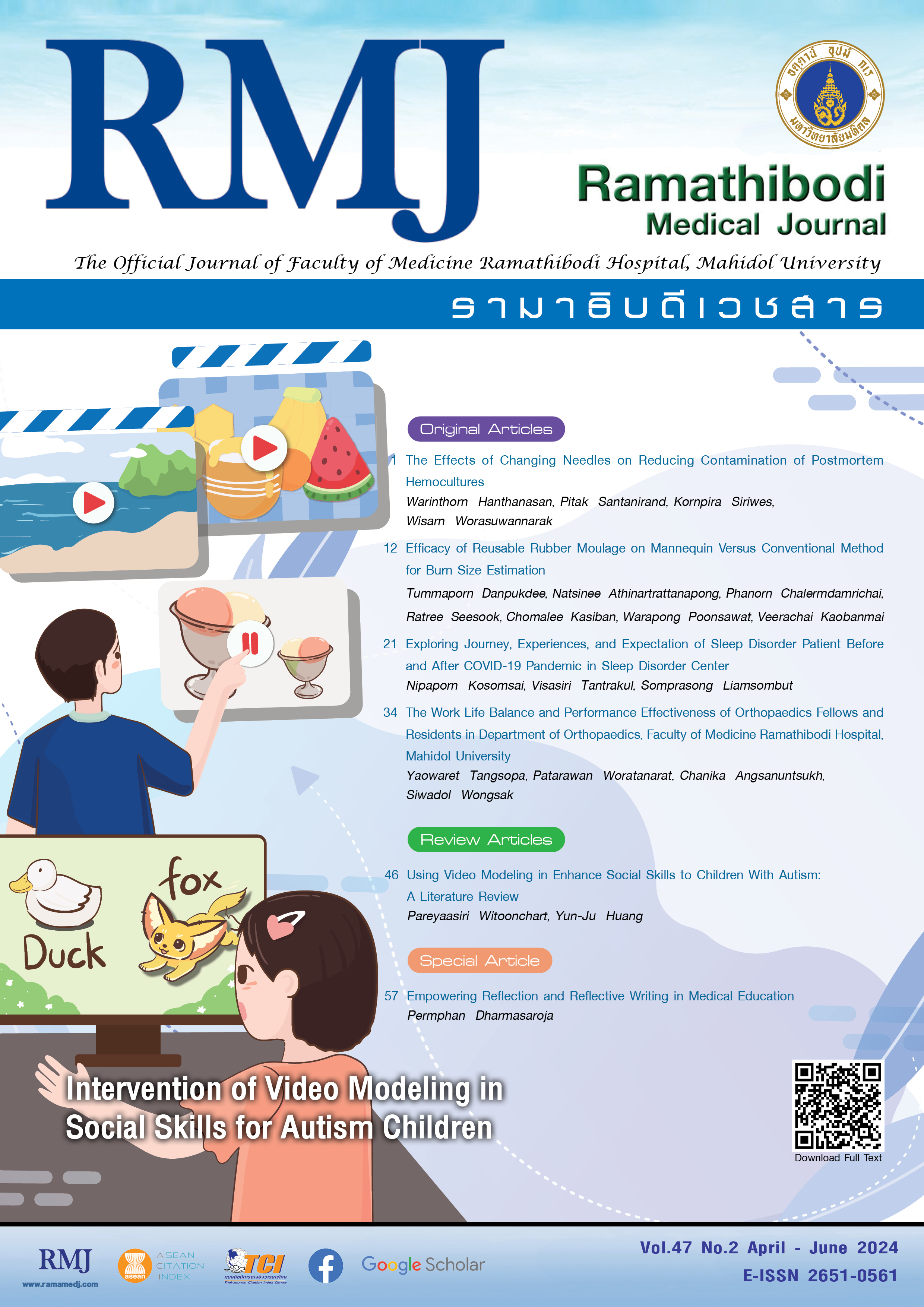การศึกษาผลของการเปลี่ยนเข็มในการบรรจุเลือดลงขวดเพาะเชื้อแบคทีเรียเพื่อลดการปนเปื้อนจากการตรวจหาเชื้อในเลือดผู้เสียชีวิต
Main Article Content
บทคัดย่อ
บทนำ: การติดเชื้อในกระแสเลือดเป็นหนึ่งในสาเหตุการตายที่สำคัญในศพที่เสียชีวิตไม่ทราบเหตุ การเจาะเลือดเพื่อตรวจเพาะเชื้อจากศพนั้นมีโอกาสเกิดการปนเปื้อนได้ หนึ่งในวิธีลดการปนเปื้อนที่ยังมีการถกเถียงกันว่ามีผลลดอัตราการปนเปื้อนหรือไม่คือการเปลี่ยนเข็มก่อนบรรจุลงขวดเพาะเชื้อแบคทีเรีย
วัตถุประสงค์: เพื่อศึกษาเปรียบเทียบอัตราการปนเปื้อนจากการตรวจหาเชื้อในเลือดผู้เสียชีวิตระหว่างกลุ่มที่เปลี่ยนเข็มกับกลุ่มที่ไม่ได้เปลี่ยนเข็ม
วิธีการศึกษา: การศึกษาแบบไปข้างหน้าโดยเจาะเลือดจากศพที่ได้รับการผ่าชันสูตรที่โรงพยาบาลรามาธิบดี โดยศพที่นำเข้าร่วมวิจัยเป็นศพที่เสียชีวิตไม่เกิน 24 ชั่วโมง และไม่สงสัยภาวะติดเชื้อ จำนวนทั้งสิ้น 40 ราย จากนั้นนำตัวอย่างเลือดที่ได้มาแบ่งบรรจุลงขวดเพาะเชื้อแบคทีเรียด้วยวิธีการเปลี่ยนเข็มและไม่เปลี่ยนเข็มก่อนบรรจุ และนำผลที่ได้จากการเพาะเชื้อมาวิเคราะห์เพื่อหาความแตกต่างกันระหว่าง 2 วิธี
ผลการศึกษา: อัตราการเพาะเชื้อให้ผลบวกในกลุ่มที่เปลี่ยนเข็ม คิดเป็นร้อยละ 57.5 และกลุ่มที่ไม่เปลี่ยนเข็ม คิดเป็นร้อยละ 57.5 โดยไม่พบความแตกต่างกัน (P = 1.00) ค่า Kappa coefficient เท่ากับ 0.795 โดยเชื้อที่พบการปนเปื้อนบ่อยที่สุด ได้แก่ Viridans group streptococci, Escherichia coli, Klebsiella pneumoniae complex, Enterobacter cloacae complex, และ Acinetobacter baumannii complex
สรุป: การเปลี่ยนเข็มไม่มีผลต่อการลดอัตราการปนเปื้อนจากการตรวจเพาะเชื้อในเลือดผู้เสียชีวิต และเชื้อที่ตรวจพบปนเปื้อนจากการตรวจเพาะเชื้อจากศพส่วนใหญ่เป็นเชื้อในช่องปาก ทางเดินอาหาร และเชื้อในโรงพยาบาล
Article Details

This work is licensed under a Creative Commons Attribution-NonCommercial-NoDerivatives 4.0 International License.
All articles are distributed by the Creative Commons Attribution (CC BY-NC-ND) license. Copyright © 2024 by the Authors. Licensee RMJ, Faculty of Medicine Ramathibodi Hospital, Mahidol University, Bangkok, Thailand.
References
Riedel S. The value of postmortem microbiology cultures. J Clin Microbiol. 2014;52(4):1028-1033. doi:10.1128/JCM.03102-13
Sunagawa K, Sugitani M. Post-mortem detection of bacteremia using pairs of blood culture samples. Leg Med (Tokyo). 2017;24:92-97. doi:10.1016/j.legalmed.2016.12.009
Wood WH, Oldstone M, Schultz RB. A re-evaluation of blood culture as an autopsy procedure. Am J Clin Pathol. 1965;43:241-247. doi:10.1093/ajcp/43.3.241
Morris JA, Harrison LM, Partridge SM. Postmortem bacteriology: a re-evaluation. J Clin Pathol. 2006;59(1):1-9. doi:10.1136/jcp.2005.028183
Spitalnic SJ, Woolard RH, Mermel LA. The significance of changing needles when inoculating blood cultures: a meta-analysis. Clin Infect Dis. 1995;21(5):1103-1106. doi:10.1093/clinids/21.5.1103
Leisure MK, Moore DM, Schwartzman JD, Hayden GF, Donowitz LG. Changing the needle when inoculating blood cultures. A no-benefit and high-risk procedure. JAMA. 1990;264(16):2111-2112. doi:10.1001/jama.1990.03450160081034
Thamlikitkul V, Chokloikaew S, Tangtrakul T, Siripoonkiat P, Wongpreedee N, Danchaivijitr S. Blood culture: comparison of outcomes between switch-needle and no-switch techniques. Am J Infect Control. 1992;20(3):122-125. doi:10.1016/s0196-6553(05)80176-2
Kassis C, Rangaraj G, Jiang Y, Hachem RY, Raad I. Differentiating culture samples representing coagulase-negative staphylococcal bacteremia from those representing contamination by use of time-to-positivity and quantitative blood culture methods. J Clin Microbiol. 2009;47(10):3255-3260. doi:10.1128/JCM.01045-09
Blot F, Schmidt E, Nitenberg G, et al. Earlier positivity of central-venous- versus peripheral-blood cultures is highly predictive of catheter-related sepsis. J Clin Microbiol. 1998;36(1):105-109. doi:10.1128/JCM.36.1.105-109.1998
Tsokos M, Püschel K. Postmortem bacteriology in forensic pathology: diagnostic value and interpretation. Leg Med (Tokyo). 2001;3(1):15-22. doi:10.1016/s1344-6223(01)00002-5
Smart D, Baggoley C, Head J, Noble D, Wetherall B, Gordon DL. Effect of needle changing and intravenous cannula collection on blood culture contamination rates. Ann Emerg Med. 1993;22(7):1164-1168. doi:10.1016/s0196-0644(05)80983-7
Spiegelhauer MR, Yusibova M, Rasmussen IKB, Fuglsang KA, Thomsen K, Andersen LP. a case report of polymicrobial bacteremia with Weissella confusa and comparison of previous treatment for successful recovery with a review of the literature. Access Microbiol. 2020;2(5):acmi000119. doi:10.1099/acmi.0.000119
Ventura Spagnolo E, Stassi C, Mondello C, Zerbo S, Milone L, Argo A. Forensic microbiology applications: a systematic review. Leg Med (Tokyo). 2019;36:73-80. doi:10.1016/j.legalmed.2018.11.002
Mesli V, Neut C, Hedouin V. Postmortem bacterial translocation. In: Carter DO, Tomberlin JK, Benbow ME, Metcalf JL, eds. Forensic Microbiology. John Wiley & Sons; 2017:192-211. doi:10.1002/9781119062585.ch8




